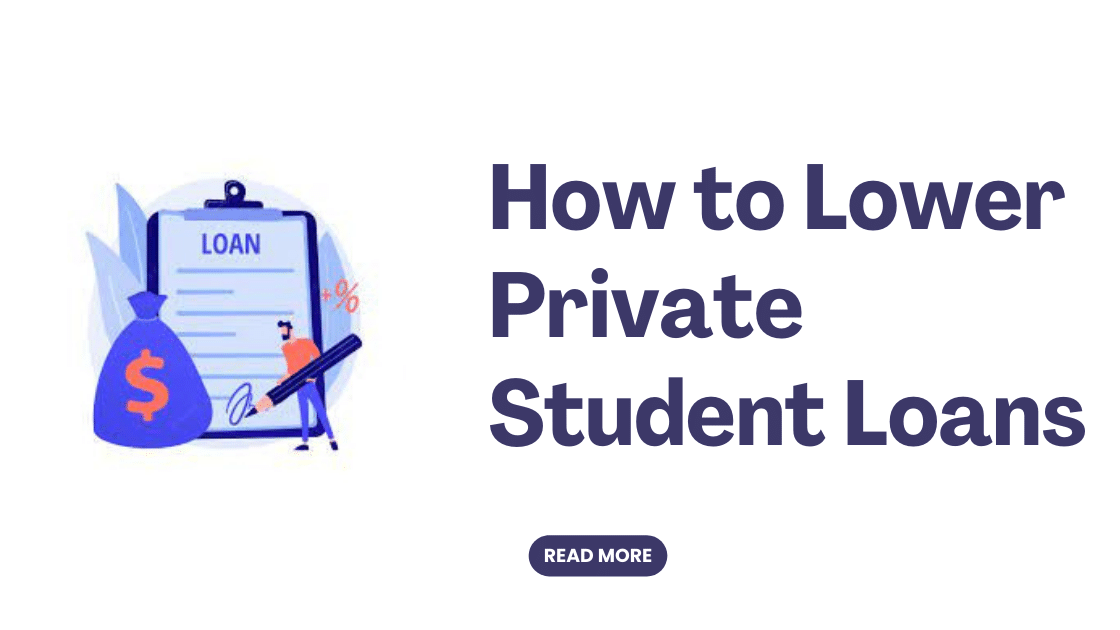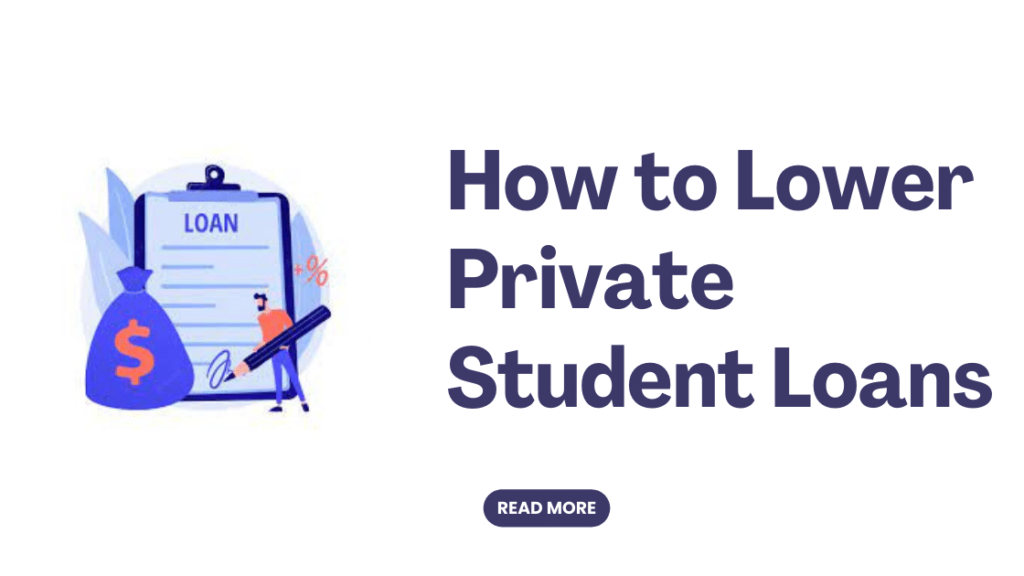How to Lower Private Student Loans: Private student loans can be a valuable resource for funding higher education, but they often come with high interest rates and inflexible repayment options. To help alleviate the financial burden, this article will provide practical tips and strategies for effectively managing private student loan costs. By exploring the need for private student loans and understanding the differences between federal and private loans, borrowers can make informed decisions to lower their loan expenses.
If you have any questions About How to Lower Private Student Loans Article you can ask us from the comment section given below.
How to Lower Private Student Loans

Exploring the need for private student loans | How to Lower Private Student Loans
Private student loans are often necessary when federal loans and other financial aid options are not sufficient to cover the full cost of tuition, books, and other educational expenses. While federal loans have borrowing limits, private loans can provide additional funding to bridge the financial gap. It is important to carefully assess your financial situation and only borrow what is truly necessary to avoid excessive debt.
Highlighting the differences between federal and private student loans | How to Lower Private Student Loans
When considering student loans, it is crucial to understand the distinctions between federal and private loans. Federal loans are offered by the government and typically have lower interest rates, fixed terms, and various repayment plans. Private loans, on the other hand, are provided by private financial institutions and often come with higher interest rates and fewer repayment options. It is essential to compare the terms, interest rates, and repayment flexibility of both types of loans before making a decision.
Evaluating Loan Options and Making Informed Decisions | How to Lower Private Student Loans
A. Researching and comparing private lenders
Before choosing a private lender, thorough research is necessary. Look for reputable lenders that offer competitive interest rates, favorable repayment terms, and a solid track record of customer satisfaction. Online comparison tools and consumer reviews can be valuable resources in evaluating and selecting the most suitable lender.
B. Assessing loan terms, interest rates, and repayment options
Carefully review the loan terms and conditions provided by private lenders. Pay particular attention to the interest rates, repayment schedules, and any associated fees. Compare these details among different lenders to ensure you choose a loan that aligns with your financial goals and capabilities. Additionally, consider the available loan repayment options and choose a plan that accommodates your income and financial situation.
Developing a Solid Financial Plan | How to Lower Private Student Loans
A. Creating a budget that accommodates loan repayment
To effectively manage private student loans, it is important to create a comprehensive budget that accounts for loan repayment. Start by tracking your monthly income and expenses. Allocate a portion of your income towards loan repayment while ensuring you can still cover essential needs and save for emergencies. A well-structured budget will help you stay on track and avoid unnecessary debt.
B. Identifying potential income sources and cost-saving strategies
Finding additional sources of income can help accelerate loan repayment and reduce interest costs. Consider part-time employment, freelance work, or other income-generating opportunities to supplement your primary income. Additionally, explore cost-saving strategies such as buying used textbooks, carpooling, or opting for affordable housing options. Saving money on everyday expenses can free up funds to allocate towards loan repayment.
Strategizing Loan Repayment | How to Lower Private Student Loans
A. Understanding the consequences of loan deferment and forbearance
Loan deferment and forbearance can provide temporary relief from making loan payments, but it is important to understand the potential consequences. Interest may continue to accrue during these periods, increasing the overall loan costs. If possible, continue making at least partial payments to prevent the interest from capitalizing and increasing the total loan amount.
B. Utilizing repayment strategies to lower overall loan costs
- Snowball method
The snowball method involves focusing on paying off the smallest student loan balance first while making minimum payments on other loans. Once the smallest loan is paid off, the money previously allocated to it can be applied to the next smallest balance. This approach builds momentum and provides a sense of accomplishment, motivating borrowers to continue paying off their loans.
- Avalanche method
The avalanche method prioritizes paying off loans with the highest interest rates first, regardless of their balance. By targeting high-interest loans, borrowers can reduce the overall interest accrued over time. Once the loan with the highest interest rate is paid off, the money previously allocated to it can be directed towards the next loan in line, accelerating the repayment process.
- Income-driven repayment plans
For borrowers struggling to meet their private student loan payments, income-driven repayment plans may be an option. Some private lenders offer income-based repayment plans that adjust monthly payments based on the borrower’s income and family size. This can provide more manageable payment amounts, but it’s important to understand the potential implications of extending the repayment term and potentially paying more in interest over time.
Negotiating with Lenders for Better Terms | How to Lower Private Student Loans
A. Techniques to negotiate for lower interest rates or fees
Negotiating with private lenders can potentially lead to better loan terms. Start by gathering competitive offers from other lenders and leverage these to negotiate with your current lender. Highlighting your creditworthiness and consistent repayment history may also strengthen your negotiating position. Be prepared to provide documentation of any improved credit scores or financial situations that may warrant better loan terms.
B. Seeking refinancing or consolidation options
Refinancing or consolidating private student loans can help reduce interest rates and simplify the repayment process. Consider exploring these options if you have established a good credit history since taking out the loans, as it could result in more favorable terms. Refinancing allows borrowers to obtain a new loan with improved terms, while consolidation combines multiple loans into a single loan, streamlining repayment and potentially lowering interest rates.
Exploring Loan Forgiveness and Discharge Programs | How to Lower Private Student Loans
A. Investigating loan forgiveness opportunities for various professions
Some professions offer loan forgiveness programs that can significantly reduce or eliminate student loan debt. Research the loan forgiveness programs available in your field of study or desired career path. These programs often require a certain number of years of service or employment in specific locations, so it is important to plan accordingly and fulfill the necessary requirements to qualify for forgiveness.
B. Analyzing loan discharge options in cases of financial hardship
In cases of extreme financial hardship, loan discharge may be a viable option. Private student loans usually have less flexible discharge options compared to federal loans, but it is worth exploring the available options. Bankruptcy, disability, or the closure of the educational institution may qualify for loan discharge in certain circumstances. Consulting with a financial advisor or loan counselor can provide valuable guidance in navigating these processes.
Seeking Additional Resources and Assistance | How to Lower Private Student Loans
A. Identifying scholarships, grants, and tuition reimbursement opportunities
Take advantage of scholarships, grants, and tuition reimbursement programs offered by educational institutions, employers, or philanthropic organizations. These additional funding sources can help reduce the reliance on student loans and lessen the financial burden of education. Explore both local and national opportunities to maximize your chances of securing financial assistance.
B. Exploring financial counseling services for personalized guidance
Financial counseling services can provide personalized guidance to effectively manage private student loan costs. These professionals can assist with budgeting, loan repayment strategies, and debt management plans tailored to your specific financial situation. Seek out accredited financial counseling organizations to ensure you receive trustworthy advice and support.
Addressing Default and Delinquency | How to Lower Private Student Loans
A. Understanding the consequences of defaulting on private student loans
Defaulting on private student loans can have severe consequences. It can damage your credit score, lead to wage garnishment, and potentially result in legal action by the lender. Additionally, defaulted loans may accrue additional fees and interest, significantly increasing the total loan amount. To avoid default, it is crucial to communicate with your lender if you encounter financial difficulties and explore alternative options, such as loan rehabilitation or settlement.
B. Navigating the process of loan rehabilitation and settlement options
If you find yourself in default or delinquency, loan rehabilitation or settlement options may help resolve the situation. Loan rehabilitation involves making a series of affordable payments to bring the loan out of default, while settlement may allow you to negotiate a reduced payoff amount. It is important to fully understand the implications of each option, as they may have different consequences for your credit and financial future.
Long-Term Financial Planning and Life After Loan Repayment | How to Lower Private Student Loans
A. Strategies for building post-loan financial stability
As you approach the end of your private student loan repayment, it is essential to shift your focus towards long-term financial stability. Develop a comprehensive financial plan that includes building an emergency fund, saving for retirement, and investing in your future goals. Prioritize financial literacy and continue implementing the budgeting and cost-saving strategies developed during the loan repayment period.
B. Allocating funds towards savings, investments, and future goals
Once the burden of loan repayment is lifted, allocate a portion of your income towards savings, investments, and the pursuit of future goals. Consider opening retirement accounts, exploring investment opportunities, and saving for major life milestones such as homeownership or further education. Cultivating responsible financial habits and staying focused on your financial goals will help solidify your post-loan financial stability.
Conclusion Of How to Lower Private Student Loans
In summary, managing the costs of private student loans requires a proactive approach and informed decision-making. Evaluating loan options, developing a solid financial plan, strategizing loan repayment, and exploring loan forgiveness or discharge programs are essential steps to lower overall loan costs. Seeking assistance from financial counseling services and considering negotiation or refinancing options can also provide additional relief. By adopting sound financial practices and planning for the future, borrowers can successfully navigate the path to student loan debt freedom.
Thank You For Reading How to Lower Private Student Loans Article ,If you have any questions About How to Lower Private Student Loans Article you can ask us from the comment section given below.
FAQs For How to Lower Private Student Loans
A. What is the difference between federal and private student loans?
Federal student loans are offered by the government and generally have lower interest rates, fixed terms, and flexible repayment options. Private student loans, on the other hand, are provided by private financial institutions and often come with higher interest rates and fewer repayment options.
B. Are there any specific qualifications for negotiating loan terms?
Qualifications for negotiating loan terms vary depending on the lender, but having a good credit history, a consistent repayment record, and evidence of improved financial situation can strengthen your position.
C. How does loan forgiveness work, and who is eligible?
Loan forgiveness programs vary in eligibility requirements and criteria. Some professions, such as teachers and healthcare providers, may qualify for loan forgiveness after a certain number of years of service. Research the loan forgiveness programs available in your field or desired career path to determine eligibility.
D. What are the potential consequences of loan default?
Defaulting on private student loans can damage your credit score, lead to wage garnishment, and potentially result in legal action. Defaulted loans may also accrue additional fees and interest, significantly increasing the total loan amount.
E. How can long-term financial planning positively impact loan repayment?
Long-term financial planning helps borrowers effectively manage their loan repayment by allocating funds towards loan payments, reducing expenses, and identifying additional income sources. This proactive approach allows borrowers to stay on track with their repayment goals and potentially accelerate the loan payoff process.
Also Read:
Is Earnest a Private Loan Company?

